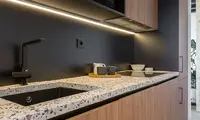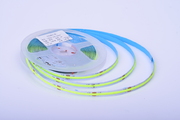COB LED Strips: A Guide on Installation and Handling
The beauty of COB LED strips lies in their adaptability and ease of installation. However, to maximize their lifespan and ensure safety, it's essential to understand the nuances of their installation and handling. In this segment, we provide a comprehensive guide on setting up COB LED strips effectively.
Installation and Handling
1. How to Install and Secure the Strip
- Clean the Surface: Before sticking or mounting the strip, ensure the surface is clean, dry, and free from grease or dust. This will ensure that adhesive backings or mounting brackets adhere well.
- Adhesive Backing: If the COB LED strip comes with an adhesive backing (commonly a 3M adhesive), simply peel off the protective layer and press the strip firmly onto the desired surface. Ensure you lay the strip evenly without any kinks.
- Mounting Clips or Brackets: For strips without adhesive or for added security, use mounting clips or brackets. Space them evenly along the strip's length and screw or adhere them to the surface. Once secured, simply click the strip into place.
- Profiles or Channels: If using aluminum channels or profiles, first mount the profile onto the desired surface. Once secured, place the LED strip inside, ensuring it sits flush against the base.
2. Connectivity Options
- Connectors: Quick-connectors are available for COB LED strips, allowing for an easy, solder-free connection. They clamp onto the end of the strip, ensuring a secure electrical connection.
- Soldering: For a more permanent and reliable connection, soldering is often recommended. Ensure the solder joints are clean and solid to avoid poor conductivity or intermittent lighting issues.
- Joining and Extending: If you need to extend the strip or navigate corners, use specialized connectors or solder small jumper wires between strips.
3. Recommended Power Supplies or Drivers
- Determine Power Requirement: Before choosing a power supply, calculate the total power consumption of the LED strip. This is typically given in watts per meter (W/m). Multiply this by the total length of the strip you plan to use.
- Voltage Matching: Ensure that the power supply’s voltage output matches the strip’s voltage requirement, commonly 12V or 24V.
- Buffer Capacity: It's a good practice to select a power supply that has a slightly higher capacity than your calculated need, often by 10-20%. This ensures the power supply isn't running at its maximum capacity continuously, which can extend its lifespan.
- Dimming: If you plan to use a dimmer, ensure both the COB LED strip and the power supply are dimmable and compatible with the dimmer type (e.g., TRIAC, 0-10V, DALI).
- Waterproofing: For outdoor installations, choose a power supply with an appropriate IP rating to ensure it's protected from moisture and other environmental factors.
Conclusion
While COB LED strips are user-friendly and adaptable, a successful installation lies in attention to detail. From preparing surfaces to ensuring robust connectivity and choosing the right power supply, each step plays a pivotal role in achieving optimal illumination and prolonging the strip's life. Proper installation and handling not only ensure safety but also enhance the visual and functional appeal of the lighting setup.




